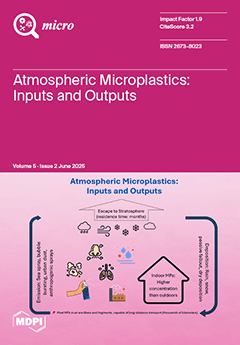The objective of this research was to fine-tune the surface properties of printed ink layers by incorporating TiO
2 and ZnO nanoparticles into conventional flexographic ink. This modification aimed to improve print quality while simultaneously providing protection against counterfeiting. The presence of nanoparticles
[...] Read more.
The objective of this research was to fine-tune the surface properties of printed ink layers by incorporating TiO
2 and ZnO nanoparticles into conventional flexographic ink. This modification aimed to improve print quality while simultaneously providing protection against counterfeiting. The presence of nanoparticles in the inks was indirectly detected through FTIR-ATR spectroscopy, which revealed changes in the fingerprint region of the ink spectrum when nanoparticles were added. This alteration enhanced the anti-counterfeiting potential of a produced print. The colorimetric measurements indicated that the addition of nanoparticles did not significantly affect the colorimetric properties of the print, since the maximal calculated ΔE
ab value was 2.83. However, the nanoparticles notably improved the ink coverage on printed line elements and allowed for the printing of elements without the characteristic outline associated with flexographic printing. The best results in terms of line definition and coverage were achieved with the addition of 2% rutile TiO
2 and 1% ZnO to the ink: the measured line segment area covered in ink was 28.5% larger than the same area printed using unmodified ink. This improvement in print quality was attributed to the modified surface free energy (SFE) of the inks, which also influenced the adhesion parameters between the printed layer and the printing substrate. The lowest total SFE was calculated for the ink without added nanoparticles (40.31 mJ/m
2), and the highest for the ink with the addition of 2% rutile TiO
2 (48.33 mJ/m
2). The work of adhesion increased after adding the nanoparticles to the ink, thereby improving the adhesion. The highest work of adhesion (79.36 mJ/m
2) was calculated for the ink with 2% rutile TiO
2. Interfacial tension was low and close to zero for all printed ink layers, and the lowest value was achieved for the ink without added nanoparticles (1.47 mJ/m
2). The findings of this research demonstrated that fine-tuning the properties of flexographic inks using nanoparticles can yield several benefits in terms of optimizing the quality of and providing counterfeit protection for specific printed motifs.
Full article





